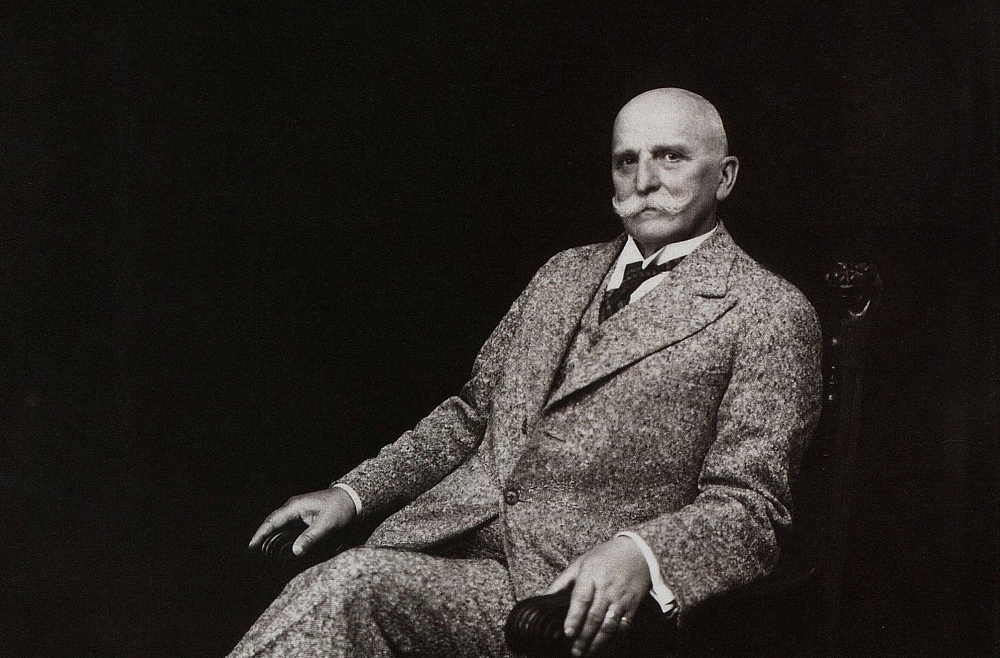Vilhelms Purvītis has done a lot for the international recognition of Latvian painting. “If we are talking about the country of Latvia, then
right from the very beginning, immediately after the de iure recognition in January 1921, the question of the representation of Latvian art abroad began. [..] Purvītis was not only the rector and the director of the City Art Museum, but also an advisor in precisely such matters,”
says Gerharde-Upeniece. A mention of 1922 follows – the Baltic states were offered to hold an exhibition at the Autumn Salon in Paris that year, and the Latvian ambassador to France Olģerds Grosvalds, as well as the ambassador to Italy Miķelis Valters and adviser Mārtiņš Nukša, were involved in the discussion about how it would happen. “Here was a question about the common image of the Baltics at the time, and also about the fact that we should think about quality – how to create, how to do,” retells Gerharde-Upeniece, “Olgerds Grosvalds turned to Vilhelm Purvīš, and Purvītis commented: “Common Baltic states organizing the exhibition, perhaps our government should now take a closer look at the state-political situation and the circles and aspirations of interested parties. In the nearest future, you can already expect invitations to the big, international exhibitions of foreign art. [..] It is thought and expected that European art nations in these cases [te runa par mazākām tautām]each will act independently and independently of political associations.”” This is what happened, that is, the small nations each went to the European art centers on their own, and only in the 1930s, during the authoritarian regimes, did the Baltic countries come together.
Gerharde-Upeniece focuses on the success story of independent Latvian art abroad:
“The first exhibition of Latvian art abroad was in Stockholm in 1927. The exhibition was held with great success.
The exhibition catalog has also been preserved. There was also a Swedish exhibition at the City Art Museum. This cultural diplomacy, where political issues can be discussed together with art… This was the first application. And it is not for nothing that in 1929, the Swedish king paid a return visit to Riga. In fact, Purvītis carried out this first mission, of course, together with the Ministry of Foreign Affairs and the team. It was really, really important.”
Also in the following decade, Purvītis was the curator of several exhibitions, and this was a certain guarantee of success, notes the head of the Latvian Visual Arts Department of LNMM, listing a number of cities to which the expositions went: “in 1933, Oslo, Helsinki; in 1936, right next door – Tallinn, Tartu ; in 1937 Vienna, Prague, Budapest, right next door – Kaunas; in 1938 Copenhagen.” But the greatest moment of success was experienced in 1939, when the exhibition of Latvian art was held at “Jeu de Paume” in Paris.
Gerharde-Upeniece highlights an aspect that accompanied Purvīš’s path as a cultural diplomat – he fit in well in the highest circles, knew how to meet in an audience and, as evidenced by preserved documents, he had, for example, with the Danish king Christian X: “Here we can talk about a certain diplomatic etiquette. He could fit perfectly into the elite circles both with behavior and language. At that time he was already looked upon as an authority. I think that a smile, not a loud laugh, talking not over each other, but the kind of talking that instills and meets , behavior, etiquette, which is at that time – he managed it in a wonderful way and that is why he was invited in such matters. He was like a guest of honor.”
When creating exhibitions, Vilhelms Purvītis taught to combine the traditional with modernism and in the 1930s to include folk art in the exhibitions. He was an exhibition curator in the modern sense – someone who selects works and thinks about space,
confirms Gerharde-Upeniece. She illustrates this with an example: the 1939 exhibition from Paris “Jeu de Paume” later traveled to the Royal Institute of Architecture in London, where the premises are completely different; Purvītis stated that there cannot be a “booth effect” here, when work is done close to each other in smaller rooms. The catalog of the London exhibition shows that there were fewer works today, but the selection was still versatile.
The works of Vilhelm Purviš himself were also in foreign exhibitions, but they did not dominate, but fit into that period and context. “It’s not a matter of numbers. Rather, he evaluated himself very modestly. It’s about exhibitions where there were [Kārlis] Hoon, this older generation and then there is [Janis] Rozentāls, Johans Walters and Purvītis, also modernists – Jāzeps Grosvalds, Jēkabs Kazāks, Valdemārs Tone. Such a panoramic scene,” says the head of the Latvian Visual Arts Department of LNMM, “For that time, it was very important in Latvia. Because
if the works have been in Paris, if they have been exhibited internationally, they have a different value. It’s not a financial value, but a self-esteem value.”
Early success at exhibitions helps later. The head of the Latvian Visual Arts Department of LNMM mentions the recent Exhibition of Baltic Symbolism in Paris, where you received the question – when did you have your last exhibition in Paris? In the talks, I had to mention both the year 1937 with the Baltic Pavilion, and the year 1939 and the Latvian art exhibition in Paris. Therefore, we have to admit that Vilhelms Purvītis has done a great job not only in his time, but also for the future.
–
Highlight the text and press Ctrl+Enterto send the text fragment to be corrected to the editor!
Highlight the text and press on Report a bug buttons to send the text fragment to be corrected to the editor!
–
–


